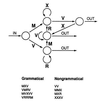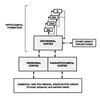Structure and function of declarative and nondeclarative memory systems
- PMID: 8942965
- PMCID: PMC33639
- DOI: 10.1073/pnas.93.24.13515
Structure and function of declarative and nondeclarative memory systems
Abstract
This article reviews recent studies of memory systems in humans and nonhuman primates. Three major conclusions from recent work are that (i) the capacity for nondeclarative (nonconscious) learning can now be studied in a broad array of tasks that assess classification learning, perceptuomotor skill learning, artificial grammar learning, and prototype abstraction; (ii) cortical areas adjacent to the hippocampal formation, including entorhinal, perirhinal, and parahippocampal cortices, are an essential part of the medial temporal lobe memory system that supports declarative (conscious) memory; and (iii) in humans, bilateral damage limited to the hippocampal formation is nevertheless sufficient to produce severe anterograde amnesia and temporally graded retrograde amnesia covering as much as 25 years.
Figures








References
-
- Knowlton B J, Squire L R, Gluck M. Learn Mem. 1994;1:106–120. - PubMed
-
- Knowlton B J, Mangels J A, Squire L R. Science. 1996;273:1399–1402. - PubMed
-
- Knowlton, B. J., Squire, L. R., Paulsen, J. S., Swerdlow, N., Swenson, M. & Butters, N. (1996) Neuropsychology, in press.
-
- Malamut B L, Saunders R C, Mishkin M. Behav Neurosci. 1984;98:759–769. - PubMed
-
- McDonald R J, White N M. Behav Neurosci. 1993;61:260–270. - PubMed
Publication types
MeSH terms
Grants and funding
LinkOut - more resources
Full Text Sources
Other Literature Sources
Medical

